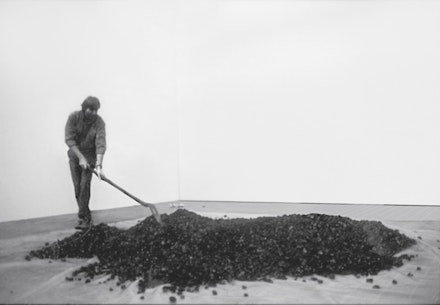ArtSeen
Bernar Venet: 1961 & 1963: les origins

On View
Ceysson & BénétièreSeptember 4 – October 9, 2021
Paris
I first found Bernar Venet, distinguished doyen of congealed loop de loops (Indeterminate Lines), in 1969 at the Museum of Contemporary Art, Chicago Art By Telephone exhibition that emphasized emerging conceptual-minimal artists. Venet’s current show, 1961 & 1963: les origins at Ceysson & Bénétière Paris, puts him back into that post-Duchampian / Yves Klein context with early minimal works that ponder the power of black and the pull of gravity through an inter-disciplinarian methodology. (The show skips 1962 because Venet was in Algeria on military service that year.)
Venet’s 1961 breakthrough as an artist was inspired by a tar spill. It manifests with his first black industrial paint on cardboard paintings called Scraps (Déchets in the original French) and Gravier Goudron (Gravel Tar) (1961); an outré sound art recording of a clattering wheelbarrow circling the gravel yard of the Tarascon military barracks where he was stationed. That hardware centers many intentionally unaesthetic Scraps that resemble garage workstations for automobile oil changes. Conversely, listening to the recording charmed me with repetitive jingling, at once musically plaintive and pitiable, similar to the Joe Jones or Jean Tinguely tinkling machine recordings.
Sometimes, as with the triptych Goudron (1961), Venet used his feet to smear tar around sheets of paper; à la Gutai artist Kazuo Shiraga’s foot paintings of the mid 1950s. Implying disrespect for aficionados of painting, it is shorn of any auxiliary symbolic-poetic associations and might have set Venet’s path towards the worst of all possible worlds: formalist solipsism. Indeed, Venet’s self-stated goal was to remove any form of expression in art in order to reduce it to material fact.
The audio/materialistic juxtaposition puts in play notions of visual opacity connected to the vibrational trembling of sonic perception. As a mandated military man, Venet seems tormented by an itch for exalting dumb materiality tinged with the flux of temporal values. As such, his early work hovers in a suspension between stupefaction and passion.
The same year, 1961, Venet had himself photographed strewn among garbage. Performance in Garbage was an explicit response to Klein’s Le Vide (The Void) (1958) exhibition at Galerie Iris Clert. Based on Rosicrucian metaphysical ideology, Klein avowed to indicate to the world a new “Age of Space” and cleaned out and whitewashed the gallery. For Performance in Garbage, Venet, in contradiction with Klein and in front of fellow soldiers, lay bare-chested among garbage as his accomplice, Jean-Pierre Quarez, photographed the brief performance. That cannot help but recall Arman’s earlier answer to Klein, Le Plein (The Full) (1960), in which Arman filled Galerie Iris Clert to the brim with garbage.
In 1963, the paintings become elegantly restrained, climaxing as black monochromes. Here Venet situates himself within a rich archaeology of Western contemplative black magic. Yet his choice of solid black also denotes the humbleness of the Black Monks and reminds us of Venet’s early religiosity. He once considered becoming a missionary. But in 1963, his stated aim was the making of self-referential art intentionally devoid of spiritual expression, which proved impossible. The black monochromes convey a Klein-esque transcendent-timeless depth. Glances are absorbed into a shimmering black excess without fixity and produce the contrary: an inexpressive neutrality.
With the color black and material viscosity still as their raison d’être, Cardboard Reliefs (1963) are heavily spray-painted black monochromes of industrial car paint applied by professionals. But as pointed out by Ben Vautier, these black monochromes came too close to Ad Reinhardt’s, whose black requiem for expressionistic painting was already well underway, even though Reinhardt’s mat surfaces suggest a mystical darkness that can permeate the mind like perfume, and Venet’s don’t.
But in 1963, Venet was on a black roll, with a poem “Noir et noir et noir” (Black and Black and Black) that is pretty far out in the post-humanist mode, and the achingly beautiful—if nihilistic—Black Book (1963), printed with only black pages. With those works and the melancholy grandeur of Pile of Coal (1963) Venet found his capacity as a visual poet of the tragic-comedic material world. Created by gravity, the very physical yet ephemeral pile, predating Robert Smithson’s Gravel Corner Piece (1968), has no specified shape or dimensions and feels amusingly random.
The 1963 Tars series puts his mysticism at bay through activating Duchamp’s desire to trade paintbrush painting for a sensual-intellectual-spiritual stance. Venet poured warm tar onto horizontal canvases, spreading it evenly over the surface and orchestrating gravitational downward flows as it hardened.
Following gravity downstairs, I found behind a black curtain a projection of Tarmacadam (1963), his black and white film of a stretch of asphalt highway passing under his car. It shares the same materialism and metaphysical pessimism—and the same ruthless realism—with the rest of the show. But designating almost unaltered material as art proved not to be the way for Venet to pave the road to the audacious digital future.

